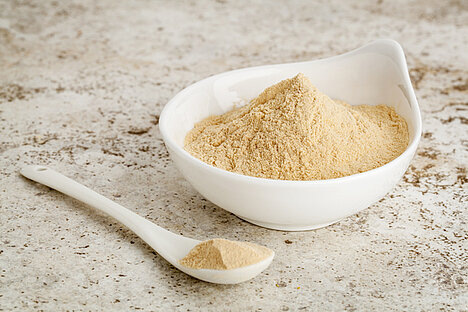Maca

But what about maca for dogs? Can you feed this miracle tuber to your four-legged friend? And if so, how much and how often? In this article, you'll find out everything you need to know about maca for dogs.
Benefits of maca for dogs
Maca can also have some positive effects for dogs, especially for older or sick animals. Here are some of the potential benefits of maca for dogs:
- Maca can increase energy and stamina in dogs, which can be especially useful for older or sluggish dogs. Maca can also strengthen muscles and promote recovery after physical exertion.
- Maca can improve the hormonal balance of dogs, which can have a positive effect on fertility, sexual function and the coat. Maca can also help to alleviate hormone-related complaints such as stress, anxiety or depression.
- Maca can strengthen the immune system of dogs and protect them from infections and inflammation. Maca also has an antioxidant effect that protects cells from free radicals and slows down the ageing process.
- Maca can improve dogs' digestion and help them absorb nutrients better. Maca can also stimulate appetite and support weight regulation.
Disadvantages of maca for dogs
Although maca is a natural product, that doesn't mean it can't have side effects or risks. Here are some of the possible disadvantages of maca for dogs:
- Maca can cause allergic reactions such as skin rash, itching or breathing difficulties in some dogs. Therefore, when feeding Maca for the first time, you should pay attention to your dog's reaction and consult a vet if in doubt.
- Maca can cause gastrointestinal problems such as diarrhea, flatulence or nausea in some dogs. This is because maca contains a lot of fiber, which can impair digestion. To avoid this, you should only give your dog small amounts of maca and increase them slowly.
- Maca can lead to hormonal fluctuations in some dogs, which can have a negative effect on their behavior or health. This is especially true for dogs with hormonal disorders such as thyroid problems or diabetes. If your dog suffers from such diseases, you should consult a vet before giving Maca.
How do I give my dog Maca?
If you want to give your dog Maca, there are a few things you should bear in mind:
- Choose a high quality source of Maca. There are various forms of Maca on the market, such as powder, capsules or extracts. Make sure the product is pure and organic and contains no additives or fillers.
- Start with a low dose and increase it slowly. The recommended dosage of Maca for dogs depends on their weight. A general guideline is about 1/4 teaspoon per 10 kg of body weight per day. You can adjust the dose as needed, but don't overdo it.
- Mix maca with food or a treat. You can simply mix the maca powder into the food or mix it with a little water or honey to make a paste and give it as a treat. You can also buy ready-made maca treats or make your own.
- Monitor your dog for possible side effects. If your dog shows signs of intolerance or overdose, such as vomiting, diarrhea or restlessness, you should stop giving him maca.
Maca is a nutrient-rich plant from South America that can have many health benefits for humans and dogs. It can improve energy, hormones, the immune system and digestion in dogs. However, care should be taken when feeding maca and the recommended dosage should be adhered to. Not all dogs tolerate maca well or even need it.
If you notice any signs of hypersensitivity or poisoning in your dog, you should see your vet immediately. We are not a substitute for a vet, but we try to be as accurate as possible. Every dog reacts differently and we recommend you get a second opinion or consult your vet if in doubt.
Stay healthy and take good care of your four-legged friend!😊
Similar to Maca
Ginseng belongs to the Araliaceae family and grows mainly in China, Korea and Japan. The plant has green leaves and red berries, but the most important thing is its fleshy root. This has the shape...
Sleepberry, or ashwagandha, is a plant native to the arid regions of India, the Middle East and parts of Africa. It is known for its robust properties and has been used in traditional Indian...
Rhodiola Rosea is a plant native to the cold regions of Europe and Asia. It has been used for centuries in traditional medicine to combat stress, increase stamina and improve overall vitality....
Earth thorn is a herbaceous plant characterized by its prickly fruits. It grows in dry climates and is known for its robust survival skills. The plant has a long history in the traditional medicine...



